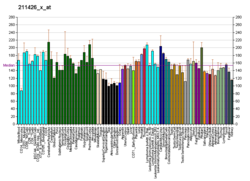GNAQ
Guanine nucleotide-binding protein G(q) subunit alpha is a protein that in humans is encoded by the GNAQ gene.[5] Together with GNA11 (its paralogue), it functions as a Gq alpha subunit.[6]
Function
|
Further information: Gq alpha subunit |
Guanine nucleotide-binding proteins are a family of heterotrimeric proteins that couple cell surface, 7-transmembrane domain receptors to intracellular signaling pathways. Receptor activation catalyzes the exchange of GDP for GTP bound to the inactive G protein alpha subunit resulting in a conformational change and dissociation of the complex. The G protein alpha and beta-gamma subunits are capable of regulating various cellular effectors. Activation is terminated by a GTPase intrinsic to the G-alpha subunit. G-alpha-q is the alpha subunit of one of the heterotrimeric GTP-binding proteins that mediates stimulation of phospholipase C-beta (MIM 600230).[supplied by OMIM][7]
Mutations in this gene have been found associated to cases of Sturge–Weber syndrome and port-wine stains.[8]
Interactions
GNAQ has been shown to interact with:
Text is available under the CC BY-SA 4.0 license; additional terms may apply.
Images, videos and audio are available under their respective licenses.








